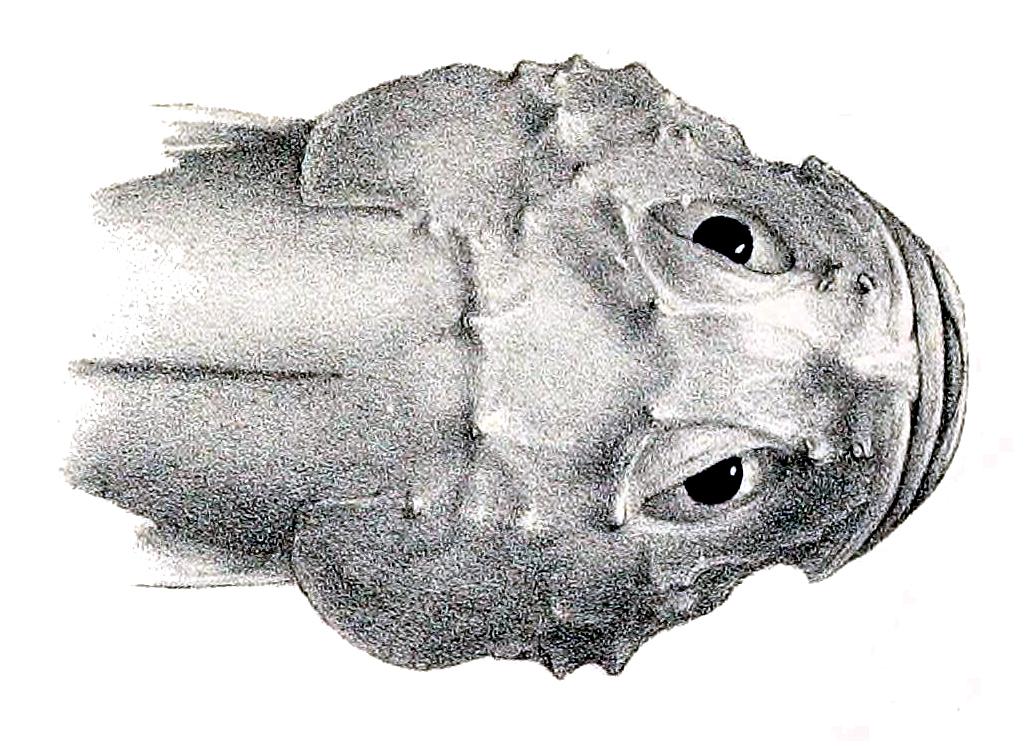|
Cottunculus Thomsonii
The pallid sculpin (''Cottunculus thomsonii'') is a species of fish in the family Psychrolutidae (blobfishes). Etymology The specific name refers to Charles Wyville Thomson. Description The pallid sculpin is up to in length and up to in weight. It is greyish-brown in colour. Habitat The pallid sculpin is bathydemersal Demersal fish, also known as groundfish, live and feed on or near the bottom of seas or lakes (the demersal zone).Walrond Carl . "Coastal fish - Fish of the open sea floor"Te Ara - the Encyclopedia of New Zealand. Updated 2 March 2009 They occ ..., living at depths of in the North Atlantic Ocean. Behaviour Feeds on small invertebrates. References {{Taxonbar, from=Q1892143 Psychrolutidae Fish described in 1882 Fish of the North Atlantic Taxa named by Albert Günther ... [...More Info...] [...Related Items...] OR: [Wikipedia] [Google] [Baidu] |
Albert Günther
Albert Karl Ludwig Gotthilf Günther FRS, also Albert Charles Lewis Gotthilf Günther (3 October 1830 – 1 February 1914), was a German-born British zoologist, ichthyologist, and herpetologist. Günther is ranked the second-most productive reptile taxonomist (after George Albert Boulenger) with more than 340 reptile species described. Early life and career Günther was born in Esslingen in Swabia (Württemberg). His father was a ''Stiftungs-Commissar'' in Esslingen and his mother was Eleonora Nagel. He initially schooled at the Stuttgart Gymnasium. His family wished him to train for the ministry of the Lutheran Church for which he moved to the University of Tübingen. A brother shifted from theology to medicine, and he, too, turned to science and medicine at Tübingen in 1852. His first work was "''Ueber den Puppenzustand eines Distoma''". He graduated in medicine with an M.D. from Tübingen in 1858, the same year in which he published a handbook of zoology for students of ... [...More Info...] [...Related Items...] OR: [Wikipedia] [Google] [Baidu] |
Psychrolutidae
The fish family Psychrolutidae (commonly known as blobfishes, toadfishes, flathead sculpins, tadpole sculpins,) contains over 35 recognized species in 8 genera. This family consists of bottom-dwelling marine sculpins shaped like tadpoles, with large heads and bodies that taper back into small, flat tails. The skin is loosely attached and movable, and the layer underneath it is gelatinous. The eyes are placed high on the head, focused forward closer to the tip of the snout. Members of the family generally have large, leaf-like pectoral fins and lack scales, although some species are covered with soft spines. This is important to the species as the depths in which they live are highly pressurized and they are ambush/opportunistic/foraging predators that do not expend energy unless they are forced to. The blobfish has a short, broad tongue and conical teeth that are slightly recurved and are arranged in bands in irregular rows along the premaxillaries; canines are completely absent. ... [...More Info...] [...Related Items...] OR: [Wikipedia] [Google] [Baidu] |
Charles Wyville Thomson
Sir Charles Wyville Thomson (5 March 1830 – 10 March 1882) was a Scottish natural historian and marine zoologist. He served as the chief scientist on the Challenger expedition; his work there revolutionized oceanography and led to his knighthood. Life Thomson was born at Bonsyde, in Linlithgow, West Lothian, on 5 March 1830, the son of Andrew Thomson, a surgeon in the service of the East India Company, and his wife Sarah Ann Drummond Smith. He was baptised Wyville Thomas Charles Thomson, and changed his name in 1876. He was educated under Charles Chalmers at Merchiston Castle School, then from 1845 studied medicine at the University of Edinburgh graduating with an MD. However, his focus turned from medicine to natural science, and he joined the Botanical Society of Edinburgh in 1847, and soon after became secretary to the Royal Physical Society of Edinburgh. In 1850 he was attending the botany class of John Hutton Balfour at the University. In 1850 he was appointed lecture ... [...More Info...] [...Related Items...] OR: [Wikipedia] [Google] [Baidu] |
Cottunculus Thomsonii2
''Cottunculus'' is a genus of fatheads found in the Atlantic, Pacific and Arctic oceans. Species There are currently 6 recognized species in this genus: * ''Cottunculus granulosus'' Karrer, 1968 (Fathead) * ''Cottunculus microps'' Collett, 1875 (Polar sculpin)Byrkjedal, I., Hadler-Jacobsen, S., Rees, D. & Orlov, A. (2014):Molecular and morphological variation in saddled fathead sculpins (Psychrolutidae: ''Cottunculus'') of the north-east Atlantic Ocean, with a synonymy of three species. ''Journal of Fish Biology, 85 (3): 821–837.'' * ''Cottunculus nudus'' J. S. Nelson, 1989 (Bonyskull toadfish) * ''Cottunculus spinosus'' Gilchrist, 1906 * ''Cottunculus thomsonii'' ( Günther, 1882) (Pallid sculpin) * ''Cottunculus tubulosus'' Byrkjedal & Orlov Orlov may refer to: Places *Orlov, Russia (''Orlova''), several inhabited localities in Russia *Orlov, Stará Ľubovňa District, village in Eastern Slovakia *Orlová, a town in Moravian-Silesian Region, Czech Republic Peo ... [...More Info...] [...Related Items...] OR: [Wikipedia] [Google] [Baidu] |
Bathydemersal
Demersal fish, also known as groundfish, live and feed on or near the bottom of seas or lakes (the demersal zone).Walrond Carl . "Coastal fish - Fish of the open sea floor"Te Ara - the Encyclopedia of New Zealand. Updated 2 March 2009 They occupy the sea floors and lake beds, which usually consist of mud, sand, gravel or rocks. In coastal waters they are found on or near the continental shelf, and in deep waters they are found on or near the continental slope or along the continental rise. They are not generally found in the deepest waters, such as abyssal depths or on the abyssal plain, but they can be found around seamounts and islands. The word ''demersal'' comes from the Latin ''demergere'', which means ''to sink''. Demersal fish are bottom feeders. They can be contrasted with pelagic fish which live and feed away from the bottom in the open water column. Demersal fish fillets contain little fish oil (one to four percent), whereas pelagic fish can contain up to 30 percent. ... [...More Info...] [...Related Items...] OR: [Wikipedia] [Google] [Baidu] |
North Atlantic Ocean
The Atlantic Ocean is the second-largest of the world's five oceans, with an area of about . It covers approximately 20% of Earth's surface and about 29% of its water surface area. It is known to separate the "Old World" of Africa, Europe and Asia from the "New World" of the Americas in the European perception of the World. The Atlantic Ocean occupies an elongated, S-shaped basin extending longitudinally between Europe and Africa to the east, and North and South America to the west. As one component of the interconnected World Ocean, it is connected in the north to the Arctic Ocean, to the Pacific Ocean in the southwest, the Indian Ocean in the southeast, and the Southern Ocean in the south (other definitions describe the Atlantic as extending southward to Antarctica). The Atlantic Ocean is divided in two parts, by the Equatorial Counter Current, with the North(ern) Atlantic Ocean and the South(ern) Atlantic Ocean split at about 8°N. Scientific explorations of the Atlant ... [...More Info...] [...Related Items...] OR: [Wikipedia] [Google] [Baidu] |
Invertebrates
Invertebrates are a paraphyletic group of animals that neither possess nor develop a vertebral column (commonly known as a ''backbone'' or ''spine''), derived from the notochord. This is a grouping including all animals apart from the chordate subphylum Vertebrata. Familiar examples of invertebrates include arthropods, mollusks, annelids, echinoderms and cnidarians. The majority of animal species are invertebrates; one estimate puts the figure at 97%. Many invertebrate taxa have a greater number and variety of species than the entire subphylum of Vertebrata. Invertebrates vary widely in size, from 50 μm (0.002 in) rotifers to the 9–10 m (30–33 ft) colossal squid. Some so-called invertebrates, such as the Tunicata and Cephalochordata, are more closely related to vertebrates than to other invertebrates. This makes the invertebrates paraphyletic, so the term has little meaning in taxonomy. Etymology The word "invertebrate" comes from the Latin word ''vertebra'', whi ... [...More Info...] [...Related Items...] OR: [Wikipedia] [Google] [Baidu] |
Fish Described In 1882
Fish are aquatic, craniate, gill-bearing animals that lack limbs with digits. Included in this definition are the living hagfish, lampreys, and cartilaginous and bony fish as well as various extinct related groups. Approximately 95% of living fish species are ray-finned fish, belonging to the class Actinopterygii, with around 99% of those being teleosts. The earliest organisms that can be classified as fish were soft-bodied chordates that first appeared during the Cambrian period. Although they lacked a true spine, they possessed notochords which allowed them to be more agile than their invertebrate counterparts. Fish would continue to evolve through the Paleozoic era, diversifying into a wide variety of forms. Many fish of the Paleozoic developed external armor that protected them from predators. The first fish with jaws appeared in the Silurian period, after which many (such as sharks) became formidable marine predators rather than just the prey of arthropods. Most fis ... [...More Info...] [...Related Items...] OR: [Wikipedia] [Google] [Baidu] |
Fish Of The North Atlantic
Fish are aquatic, craniate, gill-bearing animals that lack limbs with digits. Included in this definition are the living hagfish, lampreys, and cartilaginous and bony fish as well as various extinct related groups. Approximately 95% of living fish species are ray-finned fish, belonging to the class Actinopterygii, with around 99% of those being teleosts. The earliest organisms that can be classified as fish were soft-bodied chordates that first appeared during the Cambrian period. Although they lacked a true spine, they possessed notochords which allowed them to be more agile than their invertebrate counterparts. Fish would continue to evolve through the Paleozoic era, diversifying into a wide variety of forms. Many fish of the Paleozoic developed external armor that protected them from predators. The first fish with jaws appeared in the Silurian period, after which many (such as sharks) became formidable marine predators rather than just the prey of arthropods. Most fis ... [...More Info...] [...Related Items...] OR: [Wikipedia] [Google] [Baidu] |






